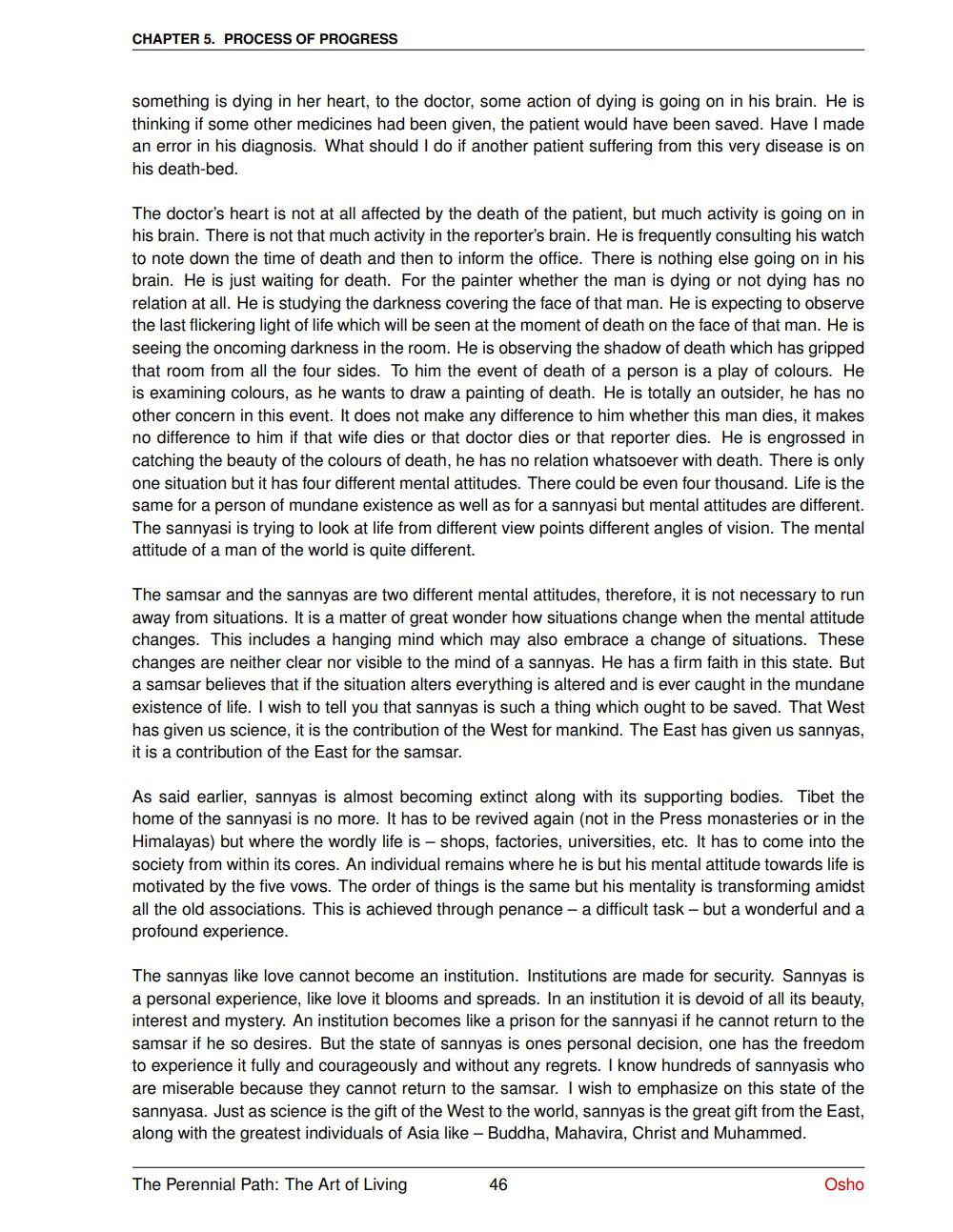________________
CHAPTER 5. PROCESS OF PROGRESS
something is dying in her heart, to the doctor, some action of dying is going on in his brain. He is thinking if some other medicines had been given, the patient would have been saved. Have I made an error in his diagnosis. What should I do if another patient suffering from this very disease is on his death-bed.
The doctor's heart is not at all affected by the death of the patient, but much activity is going on in his brain. There is not that much activity in the reporter's brain. He is frequently consulting his watch to note down the time of death and then to inform the office. There is nothing else going on in his brain. He is just waiting for death. For the painter whether the man is dying or not dying has no relation at all. He is studying the darkness covering the face of that man. He is expecting to observe the last flickering light of life which will be seen at the moment of death on the face of that man. He is seeing the oncoming darkness in the room. He is observing the shadow of death which has gripped that room from all the four sides. To him the event of death of a person is a play of colours. He is examining colours, as he wants to draw a painting of death. He is totally an outsider, he has no other concern in this event. It does not make any difference to him whether this man dies, it makes no difference to him if that wife dies or that doctor dies or that reporter dies. He is engrossed in catching the beauty of the colours of death, he has no relation whatsoever with death. There is only one situation but it has four different mental attitudes. There could be even four thousand. Life is the same for a person of mundane existence as well as for a sannyasi but mental attitudes are different. The sannyasi is trying to look at life from different view points different angles of vision. The mental attitude of a man of the world is quite different.
The samsar and the sannyas are two different mental attitudes, therefore, it is not necessary to run away from situations. It is a matter of great wonder how situations change when the mental attitude changes. This includes a hanging mind which may also embrace a change of situations. These changes are neither clear nor visible to the mind of a sannyas. He has a firm faith in this state. But a samsar believes that if the situation alters everything is altered and is ever caught in the mundane existence of life. I wish to tell you that sannyas is such a thing which ought to be saved. That West has given us science, it is the contribution of the West for mankind. The East has given us sannyas, it is a contribution of the East for the samsar.
As said earlier, sannyas is almost becoming extinct along with its supporting bodies. Tibet the home of the sannyasi is no more. It has to be revived again (not in the Press monasteries or in the Himalayas) but where the wordly life is - shops, factories, universities, etc. It has to come into the society from within its cores. An individual remains where he is but his mental attitude towards life is motivated by the five vows. The order of things is the same but his mentality is transforming amidst all the old associations. This is achieved through penance - a difficult task - but a wonderful and a profound experience.
The sannyas like love cannot become an institution. Institutions are made for security. Sannyas is a personal experience, like love it blooms and spreads. In an institution it is devoid of all its beauty, interest and mystery. An institution becomes like a prison for the sannyasi if he cannot return to the samsar if he so desires. But the state of sannyas is ones personal decision, one has the freedom to experience it fully and courageously and without any regrets. I know hundreds of sannyasis who are miserable because they cannot return to the samsar. I wish to emphasize on this state of the sannyasa. Just as science is the gift of the West to the world, sannyas is the great gift from the East, along with the greatest individuals of Asia like - Buddha, Mahavira, Christ and Muhammed.
The Perennial Path: The Art of Living
46
Osho




